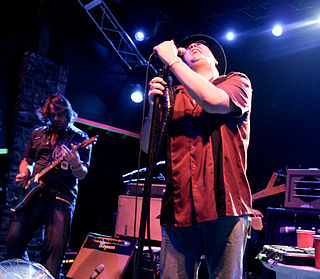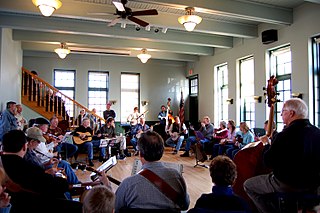 W
WIn jazz and jazz harmony, the chord progression from iv7 to ♭VII7 to I (the tonic or "home" key) has been nicknamed the backdoor progression or the backdoor ii-V, as described by jazz theorist and author Jerry Coker. This name derives from an assumption that the normal progression to the tonic, the ii-V-I turnaround (ii-V7 to I, see also authentic cadence) is, by inference, the "front door", a metaphor suggesting that this is the main route to the tonic.
 W
WIn jazz, a bar-line shift is a technique in which, during improvisation, one plays the chord from the measure before or after the given chord either intentionally or as an "accident."
 W
WBebop or bop is a style of jazz developed in the early to mid-1940s in the United States. The style features compositions characterized by a fast tempo, complex chord progressions with rapid chord changes and numerous changes of key, instrumental virtuosity, and improvisation based on a combination of harmonic structure, the use of scales and occasional references to the melody.
 W
WEmbouchure or lipping is the use of the lips, facial muscles, tongue, and teeth in playing a wind instrument. This includes shaping the lips to the mouthpiece of a woodwind instrument or the mouthpiece of a brass instrument. The word is of French origin and is related to the root bouche, 'mouth'. Proper embouchure allows instrumentalists to play their instrument at its full range with a full, clear tone and without strain or damage to their muscles.
 W
WA chord chart is a form of musical notation that describes the basic harmonic and rhythmic information for a song or tune. It is the most common form of notation used by professional session musicians playing jazz or popular music. It is intended primarily for a rhythm section. In these genres the musicians are expected to be able to improvise the individual notes used for the chords and the appropriate ornamentation, counter melody or bassline.
 W
WCosmologic was a cooperative avant-jazz quartet from California that was composed of saxophonist Jason Robinson, trombonist Michael Dessen, percussionist Nathan Hubbard, and bassist Scott Walton.
 W
WIn popular music, a cover version, cover song, remake, revival, or simply cover, is a new performance or recording by a musician other than the original performer or composer of the song.
 W
WGig is slang for a live musical performance, a paid engagement of a musician or ensemble.
 W
WIn music, groove is the sense of an effect ("feel") of changing pattern in a propulsive rhythm or sense of "swing". In jazz, it can be felt as a quality of persistently repeated rhythmic units, created by the interaction of the music played by a band's rhythm section. Groove is a significant feature of popular music, and can be found in many genres, including salsa, rock, soul, funk, and fusion.
 W
WIn popular music, half-time is a type of meter and tempo that alters the rhythmic feel by essentially doubling the tempo resolution or metric division/level in comparison to common-time. Thus, two measures of 44 approximate a single measure of 88, while a single measure of 4/4 emulates 2/2. Half-time is not to be confused with alla breve or odd time. Though notes usually get the same value relative to the tempo, the way the beats are divided is altered. While much music typically has a backbeat on quarter note (crotchet) beats two and four, half time would increase the interval between backbeats to double, thus making it hit on beats three and seven, or the third beat of each measure :1 2 3 4 1 2 3 4 1 2 3 4 5 6 7 8 1 2 3 4
 W
WA jam band is a musical group whose live albums and concerts relate to a fan culture that began in the 1960s with the Grateful Dead, who held lengthy improvisational "jams" during their concerts. These include extended musical improvisation over rhythmic grooves and chord patterns, and long sets of music which often cross genre boundaries.
 W
WA jam session is a relatively informal musical event, process, or activity where musicians, typically instrumentalists, play improvised solos and vamp on tunes, songs and chord progressions. To "jam" is to improvise music without extensive preparation or predefined arrangements, except for when the group is playing well-known jazz standards or covers of existing popular songs. Original jam sessions, also 'free flow sessions', are often used by musicians to develop new material (music) and find suitable arrangements. Both styles can be used simply as a social gathering and communal practice session. Jam sessions may be based upon existing songs or forms, may be loosely based on an agreed chord progression or chart suggested by one participant, or may be wholly improvisational. Jam sessions can range from very loose gatherings of amateurs to evenings where a jam session coordinator or host acts as a "gatekeeper" to ensure that only appropriate-level performers take the stage, to sophisticated improvised recording sessions by professionals which are intended to be broadcast live on radio or TV or edited and released to the public.
 W
WJazz improvisation is the spontaneous invention of melodic solo lines or accompaniment parts in a performance of jazz music. It is one of the defining elements of jazz. Improvisation is composing on the spot, when a singer or instrumentalist invents melodies and lines over a chord progression played by rhythm section instruments and accompanied by drums. Although blues, rock, and other genres use improvisation, it is done over relatively simple chord progressions which often remain in one key.
 W
WA lead sheet or fake sheet is a form of musical notation that specifies the essential elements of a popular song: the melody, lyrics and harmony. The melody is written in modern Western music notation, the lyric is written as text below the staff and the harmony is specified with chord symbols above the staff.
 W
WIn popular music genres such as country, blues, jazz or rock music, a lick is "a stock pattern or phrase" consisting of a short series of notes used in solos and melodic lines and accompaniment. For musicians, learning a lick is usually a form of imitation. By imitating, musicians understand and analyze what others have done, allowing them to build a vocabulary of their own.
 W
WIn jazz improvisation, outside playing describes an approach where one plays over a scale, mode or chord that is harmonically distant from the given chord. There are several common techniques to playing outside, that include side-stepping or side-slipping, superimposition of Coltrane changes, and polytonality.
 W
WPolyrhythm is the simultaneous use of two or more rhythms that are not readily perceived as deriving from one another, or as simple manifestations of the same meter. The rhythmic layers may be the basis of an entire piece of music (cross-rhythm), or a momentary section. Polyrhythms can be distinguished from irrational rhythms, which can occur within the context of a single part; polyrhythms require at least two rhythms to be played concurrently, one of which is typically an irrational rhythm. Concurrently in this context means within the same rhythmic cycle. The underlying pulse, whether explicit or implicit can be considered one of the concurrent rhythms. For example, the son clave is poly-rhythmic because its 3 section suggests a different meter from the pulse of the entire pattern.
 W
WA refrain is the line or lines that are repeated in music or in poetry — the "chorus" of a song. Poetic fixed forms that feature refrains include the villanelle, the virelay, and the sestina.
 W
WRhythm changes are a common 32-bar chord progression in jazz, originating as the chord progression for George Gershwin's "I Got Rhythm". The progression is in AABA form, with each A section based on repetitions of the ubiquitous I–vi–ii–V sequence (or variants such as iii–vi–ii–V), and the B section using a circle of fifths sequence based on III7–VI7–II7–V7, a progression which is sometimes given passing chords.
 W
WStride jazz piano, often abbreviated to stride, is a jazz piano style that arose from ragtime players. Prominent stride pianists include James P. Johnson, Willie "the Lion" Smith, Fats Waller, Luckey Roberts, and Mary Lou Williams.
 W
WThe 32-bar form, also known as the AABA song form, American popular song form and the ballad form, is a song structure commonly found in Tin Pan Alley songs and other American popular music, especially in the first half of the 20th century.
 W
WTrad jazz, short for "traditional jazz", was a form of jazz in Britain in the 1950s and 1960s, played by musicians such as Chris Barber, Acker Bilk, Kenny Ball, Ken Colyer and Monty Sunshine, based on a revival of New Orleans Dixieland jazz, on trumpet, trombone, clarinet, banjo, double bass, and drums, with a populist repertoire which also included jazz versions of pop songs and nursery rhymes.
 W
WA transposing instrument is a musical instrument for which music notation is not written at concert pitch. For example, playing a written middle C on a transposing instrument produces a pitch other than middle C; that sounding pitch identifies the interval of transposition when describing the instrument. Playing a written C on clarinet or soprano saxophone produces a concert B♭, so these are referred to as B♭ instruments. Providing transposed music for these instruments is a convention of musical notation. The instruments do not transpose the music; rather, their music is written at a transposed pitch. Where chords are indicated for improvisation they are also written in the appropriate transposed form.
 W
WIn jazz, a turnaround is a passage at the end of a section which leads to the next section. This next section is most often the repetition of the previous section or the entire piece or song.
 W
WThe West Coast School are composers and compositional style(s) associated with the West Coast of the United States, specifically California. Henry Cowell is considered, "the father of West Coast experimentalism," and the influence of traditional Asian and other world musics may be traced back to Cowell. Rather than Orient/Occident, composer Lou Harrison argues for a Pacific/Atlantic conception, where the West Coast is necessarily part of the Pacific, and thus associated with Asia more than Europe. Other influences and interests include the use of tonality, just intonation, and dance.